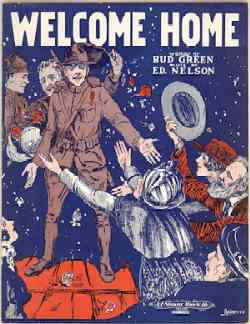|
By Steve Paul Johnson, November 9, 2000
It was known as "the War to end all Wars". The first world war is
considered today as the event which has had the greatest social and
political impact in the annals of human history. It has been estimated
that more than 61.5 million soldiers from all nations took part in the
war, of which 8.5 million were killed, 12.5 million received recoverable
injuries, and 7 million were permanently injured.
The United States, which entered the war late, suffered among the
fewest losses, at approximately 116,000. Nevertheless, the impact the war
had upon Americans was great. President Wilson, who boasted that he would
keep the United States out of the war, shocked the country with his
request for war.
November 11, 1918 marked the official end of the war. One year later,
President Wilson proclaimed November 11, 1919, as "Armistice Day". It was
the first nationwide commemoration of the war.

11th Hour, 11th Day, 11th Month
1918
On November 11, 1920, England laid to rest an unknown soldier in
Westminster Abbey, a way to commemorate their losses in the war. France
had carried a similar act the same year at the Arc de Triomphe.
On November 11, 1921, the United States followed-up with their own
version. An unknown soldier, who had already been laid to rest at a
cemetery in Europe, was selected and placed aboard a ship to Washington
D.C. It was to fill the new "Tomb of the Unknown Soldier". It was a much
hyped and heralded event that received press coverage from coast-to-coast.
Thousands of people flocked to see the body laying in state in the Capitol
rotunda. There was a funeral procession down Pennsylvania Avenue. Each
state sent in floral arrangements to adorn the tomb. President Harding
laid a wreath of flowers on the casket. Taps was played. The casket was
placed into the tomb at 11:00am. The President requested that all flags be
flown at half-mast.
Though this event had been performed a year earlier in England and
France, it had a more powerful effect among Americans. That single unknown
soldier not only symbolized America's losses, but each American's
losses and sacrifices in the war.
In the years following, 27 states had responded to that emotional event
by adopting laws declaring November 11 as a legal holiday. The United
States Congress reacted by enacting a resolution on June 4, 1926, asking
the President to issue a proclaimation to display the nation's colors on
all buildings on November 11. The resolution officially named the day,
"Armistice Day".
On May 13, 1938, Congress enacted a new law that made Armistice Day a
national holiday.
In 1947, just 2 years after the end of World War II, Raymond Weeks,
organized a "Veterans Day" parade in Birmingham, AL, to celebrate all of
America's veterans. In 1954, Kansas Representative Edwin K. Rees
introduced a bill that would change the purpose of Armistice Day to honor
veterans of all wars. On June 1, 1954, President Eisenhower signed the
bill into law, officially renaming Armistice Day to Veterans Day. 
Remembering the Fallen
Later that same year, on October 8, Eisenhower issued a proclaimation
creating a new "Veterans Day National Committee" and naming the
Administrator of the Department of Veterans Affairs as its coordinator.
The Committee would be responsible for planning all national ceremonies
and to set an example for state and local governments, as well as
providing suggestions for Americans on how to celebrate Veterans Day.
On Memorial Day of 1958, two more unknown soldiers were reinterred
along side the unknown soldier of World War I. One was a casualty of World
War II and the other one of the Korean War. In 1973, a law was passed to
add another unknown soldier from the Vietnam war, but none could be found
until 1984.
In 1968, a law was passed to change the date of Veterans Day to the
fourth Monday in October. This was done to give Americans a three-day
weekend, thus affording them time to visit cemeteries, engage in
ceremonies, and visit veterans memorials. But other Americans felt that
November 11 was too much of an important day to forget. Many states
continued to observe November 11. In 1978, President Ford signed into law
a bill that would restore November 11 as Veterans Day.
Today, the Veterans Day National Committee coordinates all federal
ceremonies relating to Veterans Day. Every November 11, a ceremony is held
in Arlington National Cemetery, at the "Tomb of the Unknown Soldier". The
President recreates the original event by placing a wreath at the tomb,
and Taps is played. The Committee coordinates similar ceremonies at
"regional sites" across the country.
|





